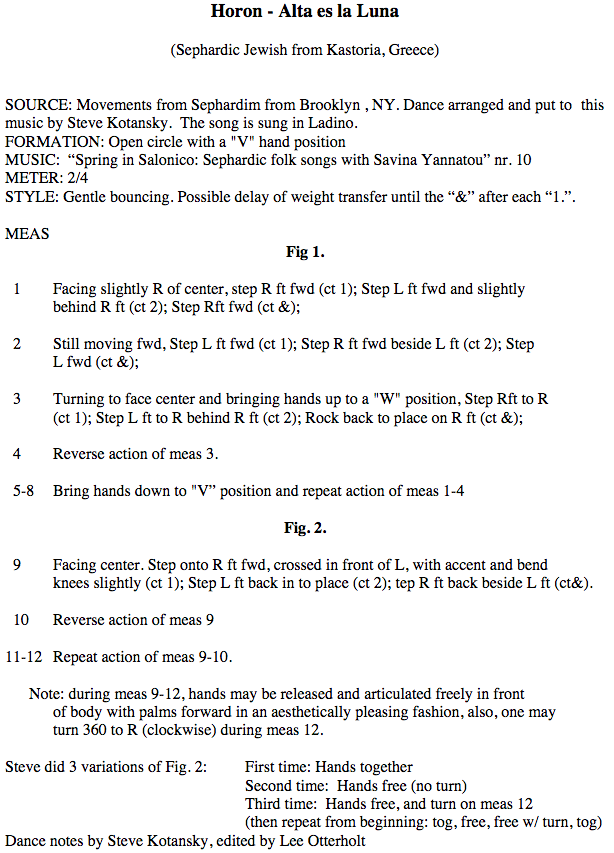*2nd Generation dance. A dance that developed and was disseminated in a non-traditional way. 2G dances are specific – have a fixed format designed to correspond with the arrangement of a particular recording, whereas 1G dances are generic – have a shorter sequence that works with live music – where many different songs are played and arrangements vary according to the tastes of musicians and dancers. For more on the differences between 1st & 2nd G dances click here.
The Song – Alta es la Luna
In 1995, Savina Yannatou, a Greek multi-genre singer-songwriter joined forces with select jazz/traditional musicians, formed a band known as Primavera en Salonico, and released a CD of Sephardic folk songs. Tracks from this CD have spawned at least three 2ndG recreational folk dances – Steve Kotansky’s Primavera en Salonico, Laura Shannon’s Hora la Galana, and Kotanksy’s Horon – Alta es la Luna.
For Ladino lyrics and an English translation, click here.
According to dance notes by Steve Kotansky and Lee Otterholt, the song Alta es la luna is from Kastoria, in what is now Greece. As the map below shows, the town is near the borders of modern Albania and Macedonia, and it has always been a cosmopolitan meeting place, having been controlled by Greeks, Macedonians. Albanians, Romans, Bulgarians, Serbs, and, beginning around 1385, the Ottoman Turks.

Jews had enjoyed some of their most favored treatment ever in Spain under ‘the crescent’ of Islam. When the Christians Ferdinand and Isabella re-conquered Spain and ordered the Jews to either convert to Christianity or leave, most Jews preferred living under ‘the crescent’ to ‘the cross’ and left for other Muslim lands. When the Sephardim left Spain for the Balkans, ca. 1492, the area was under the ‘crescent’; there was no Greece or Bulgaria, Macedonia or Albania, for instance, only Greeks, Albanians, etc living under the Ottomans. The Sephardim became yet another piece of the quilt.
The Dance – Horon – Alta es la Luna
The word Horon is Greek in origin; a relative of the Greek word horos (dance), from which we get the word chorus (chorus line), and the Bulgarians get their name for line dances, horo. Horon also happens to be the name Pontic Greeks have used for their dances, a name the Turks adopted when they took over from the Greeks, irregardless of the ethnicity of the dancers. Today, Turks still refer to the Pontus area as the Horon dance region, though very few Greeks remain.

I’m speculating that the the label Horon was attached to songs and dances of Sephardic-Greek Jews from the point of view of the ruling Turks, who first knew the Greeks of Anatolia, (where they learned the Greek term for dance, Horon,) and later applied it to any Greek dance, or any dance in a region of majority Greek population, even if they were Jewish. Perhaps the Sephardim themselves adopted the Turkish name for a dance style learned in their new surroundings. Certainly the steps chosen by Steve Kotansky to represent the song, though they’re based on steps from Brooklyn (see notes below) have the S,Q,Q, rhythm and Uneven Walking foot pattern of the classic Greek dance, Syrto.

COMMENTS:
John Uhlemann wrote: “The first person to teach this was Steve Kotansky, who saw these steps done at a Sephardic Jewish party. At that time he saw the steps done to several pieces of music, so Steve picked this tune because it was pleasant and fit the style he had heard. Most of the other people in the room just did the first part, obviously a syrto, but Steve’s eye was drawn to 3-4 older women who did a sort of mix and match depending on the music. Steve said it was from those steps that he constructed this dance. This was presented at Balkan camp, and he did not use the term “horon” at that time. About 2 years later I heard that other teachers had started teaching it with stylistic changes. (For example, the second part as a “cross, back, step” as opposed to the “cross, side step” that Steve taught.). Could it be that the other teachers did their own research? Or were they re-presenting the dance Steve taught, in light of other experiences they may have had with the style.
The “horon” part of the name should not be there, any more than one would say “horon syrto” or “Horon tsamiko”. when “horon” is applied to a dance name it is usually because the locals have no name, so we have to call it “horon Karsalideikon” (the dance from Kars), or whatever.”
